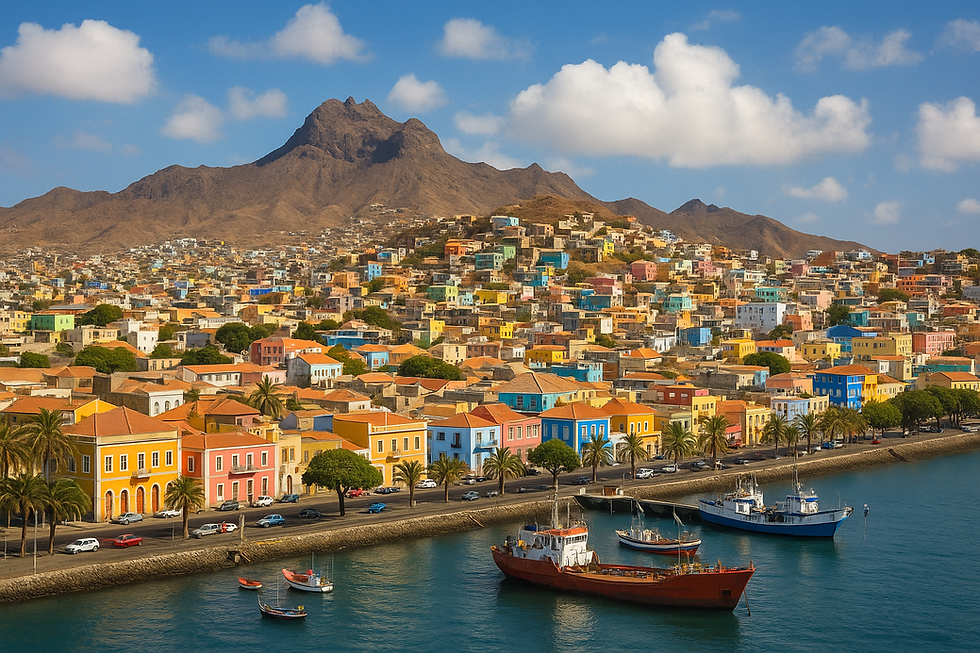Gas, Green Goals, and Geopolitics: Cyprus Charts Its ESG Future at the Edge of Europe
- tinchichan

- 4 days ago
- 5 min read
In the sunbaked plains of Nicosia, solar farms stretch across parched fields. Off the coast of Limassol, container ships idle in turquoise waters, awaiting EU-compliant clearance. Beneath the eastern Mediterranean lies a contested treasure trove of gas—and a climate clock ticking fast.
Cyprus, the EU’s easternmost member, is a frontline state for ESG in a region defined by climate extremes, energy geopolitics, and cross-border complexity. As it seeks to decarbonize, digitize, and diversify its economy, Cyprus finds itself at the intersection of green transition and regional turbulence.

“We are an energy crossroad, a climate hotspot, and an island divided,” says a senior official in the Ministry of Energy. “Our ESG strategy must deliver not just emissions cuts—but peace, water security, and regional cooperation.”
1. ESG in Context: An Island of Innovation and Tension
Population (2024): ~1.3 million
GDP (2024): ~$30 billion (nominal)
GDP per capita: ~$23,000 (nominal)
Public debt-to-GDP: ~77% (down from 115% in 2015)
EU Green Deal alignment: In progress
Climate risk: High—drought, wildfires, water stress, sea-level rise
Cyprus is:
A divided island, with the internationally recognized Republic of Cyprus in the south (EU member) and the Turkish-controlled north (recognized only by Turkey)
A services-driven economy, with tourism, shipping, and financial services contributing 80%+ of GDP
A climate hotspot, with temperatures rising faster than the global average
A country transitioning from imported fossil fuels to solar, LNG, and regional electricity interconnection
Its ESG profile is shaped by EU regulation, hydrocarbon ambition, and Mediterranean fragility—all under the shadow of unresolved territorial division and regional disputes.
2. Environmental Sustainability: Mediterranean Heat Meets Energy Transition
2.1 Climate Stress and Water Scarcity
Cyprus is one of Europe’s most climate-vulnerable countries:
Average temperatures have risen +1.3°C since 1960
2023 drought reduced reservoir capacity to ~40%
Wildfires intensified in Limassol and Paphos due to extreme heatwaves
Sea level rising ~3.3 mm/year, threatening coastal assets and heritage zones
Water management:
Heavy reliance on desalination plants (5 major plants operating)
Non-revenue water remains high (~30%) due to aging infrastructure
Treated wastewater reuse growing, especially in agriculture and landscaping
2.2 Emissions, Renewables, and Energy Transition
Energy profile (2023):
~87% of electricity from fossil fuels (mainly oil & diesel)
~13% from renewables (mainly solar PV, some wind and biomass)
No nuclear, no hydro
Electricity grid not yet interconnected to mainland Europe
Climate targets:
EU-mandated 55% GHG reduction by 2030
42.5% renewable electricity by 2030
National Energy and Climate Plan (NECP) revised in 2023 to reflect Fit for 55 package
Key projects:
EuroAsia Interconnector: 2,000 MW undersea cable linking Cyprus, Greece, and Israel (under construction)
Solar park expansion in Larnaca and Nicosia districts
Gas import terminal at Vasilikos to enable LNG regasification and reduce oil dependence
Energy efficiency retrofits in public buildings and hotels, supported by EU Recovery funds
3. Social Sustainability: Inclusion, Aging, and Tourism Transition
3.1 Human Development and Demographic Pressures
HDI (2023): 0.887 (very high)
Life expectancy: ~82 years
Urbanization: ~67%
Aging population: ~20% over 65 by 2030
Health and education:
Universal healthcare system (GESY) implemented in 2019
High tertiary education enrollment (~70% of youth)
Brain drain concerns persist in STEM and green tech sectors
Tourism:
~3.2 million visitors in 2023 (recovery post-COVID)
Transition from mass tourism to sustainable heritage and agro-tourism
ESG certifications (Green Key, ISO 14001) expanding in hotels and resorts
3.2 Migration, Gender, and Green Jobs
Migration:
Cyprus hosts ~100,000 migrant workers (~12% of population)
Asylum pressure high due to proximity to Middle East and North Africa
Social cohesion tested by housing, labor market, and integration challenges
Women:
High education levels, but gender wage gap ~12%
Underrepresented in STEM and energy sectors
Women-led cooperatives emerging in organic farming and heritage tourism
Green jobs:
EU Recovery and Resilience Plan includes €89 million for green skills training
Target sectors: solar energy, eco-construction, circular economy, agritech
4. Governance: EU-Aligned, Regionally Complex
4.1 Political Structure and ESG Regulation
Governance:
EU member since 2004; eurozone since 2008
Divided island since 1974; UN buffer zone separates the north and south
Government in Nicosia recognized internationally; north operates under separate administration
ESG regulation:
Fully subject to EU taxonomy, CSRD, and SFDR
Ministry of Environment and Energy oversees NECP, climate adaptation, and biodiversity strategies
EIA and SEA (Strategic Environmental Assessment) mandatory for major projects
4.2 Private Sector ESG and Disclosure Trends
Corporate sector:
Banks, real estate, and tourism dominate
ESG disclosure increasing due to EU CSRD compliance deadlines (2025 for most firms)
Cyprus Stock Exchange (CSE) lacks ESG index but encourages sustainability reporting
ESG movers:
Bank of Cyprus and Hellenic Bank publish sustainability reports
Hospitality sector adopting green finance and certification models
Shipping and maritime firms exploring ESG-linked financing and fuel transition (e.g., green ammonia)
5. ESG Finance: EU Funds, Green Bonds, and Blue Economy Potential
5.1 Climate and Recovery Finance Flows
Major funding sources:
€1.2 billion EU Recovery and Resilience Plan (2021–2027)
~40% for climate and digital transition
Supports energy retrofits, e-mobility, and biodiversity
EU Cohesion Policy: €968 million for 2021–2027 covering climate adaptation, circular economy, and emissions reduction
LIFE+ and Horizon Europe funding research on desertification, marine ecosystems, and climate-smart agriculture
5.2 Green Bonds, Blue Finance, and Innovation
Finance innovation:
No sovereign green bond yet, but feasibility assessed in 2024
Local banks offering green mortgages, solar loans, and SME sustainability lines
Cyprus exploring blue finance tools for fisheries, coral preservation, and marine spatial planning
EU taxonomy alignment:
Financial institutions and listed firms preparing for mandatory ESG disclosures under CSRD
Green fintech startups emerging in Limassol and Nicosia
6. ESG Case Studies: Cyprus in Transition
Case Study 1: EuroAsia Interconnector
2,000 MW electricity cable linking Cyprus to Greece and Israel
Enables grid decarbonization, energy security, and electricity exports
ESG metrics: emissions avoided, fossil fuel displacement, cross-border resilience
EU PCI (Project of Common Interest) co-funded
Case Study 2: Larnaca Solar Innovation Hub
Cluster of solar farms, agrivoltaics, and EV charging stations
Run by local cooperative with EU and private finance
Metrics: clean energy generation, agricultural yield, local jobs
Linked to university research programs
Case Study 3: Akamas Coastal Biodiversity Zone
Protected area expanded and reforested
Combats erosion, preserves turtle nesting sites, supports eco-tourism
Metrics: biodiversity index, carbon sequestration, visitor revenue
Managed with community engagement and EU LIFE+ funds
7. Comparative ESG Snapshot: Mediterranean Peers
Indicator (2023) | Cyprus | Greece | Malta | Israel | Turkey |
GHG per capita (tCO₂e) | ~7.5 | ~6.8 | ~4.9 | ~9.0 | ~6.2 |
Renewable electricity (%) | ~13% | ~46% | ~11% | ~11% | ~42% |
ESG regulation | EU-aligned | EU-aligned | EU-aligned | Moderate | Emerging |
Sovereign green bond issued | No | Yes | No | No | No |
TI Corruption Rank (2023) | 51/180 | 59 | 54 | 33 | 115 |
*Cyprus aligns with EU ESG standards, but lags in renewables share and green bond issuance—with strong potential in interconnection and blue economy leadership.
8. Strategic ESG Risks and Opportunities
Risks
Climate impacts on agriculture, water supply, and tourism
Delayed renewables deployment and grid modernization
Political division limits island-wide environmental governance
Energy transition tensions with gas development strategy
Opportunities
Issue a sovereign green bond or blue bond to fund renewable and marine resilience
Scale up solar and geothermal deployment with storage and demand flexibility
Position Cyprus as a regional green energy and ESG finance hub
Expand community-based climate adaptation and nature-based solutions
Integrate northern and southern island ESG data and climate planning for long-term unification resilience
Conclusion: ESG at the Crossroads of Continents
Cyprus is not only at the geographic and political edge of Europe—it is at the forefront of ESG transition in the Mediterranean. With its sun, sea, and strategic location, it holds the tools to lead in climate-smart infrastructure, blue finance, and regional energy interconnection.
But to fulfill that promise, Cyprus must close the gap between ambition and implementation—between the coasts and the capital, between the island’s halves, and between fossil past and green future.



Comments